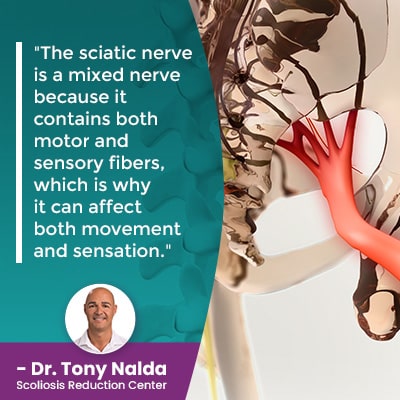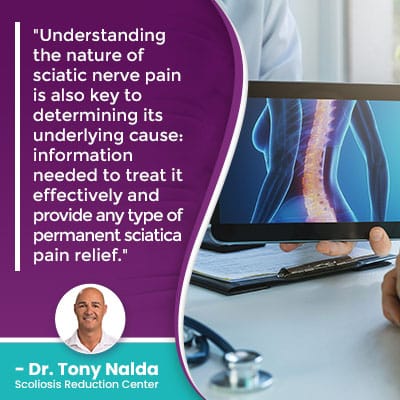Got Sciatica Pain? Learn How To Cure Sciatica Permanently

Many who have experienced nerve-related back pain describe it as the most debilitating form of back pain, and this is due to the nature of nerve pain that can be felt anywhere along an affected nerve's pathway, which can be extensive. If the sciatic nerve is exposed to uneven forces, it can become compressed, irritated, pinched, and/or impinged.
When it comes to curing sciatica pain permanently, the key is determining its underlying cause and shaping treatment around it; despite popular opinion, sciatica is not a condition, but references sciatic nerve pain caused by compression of the sciatic nerve.
Before getting to the specifics of sciatic nerve pain, let's first discuss the difference between focusing on a condition/issue's underlying cause, and solely addressing its symptoms.
Table of Contents
Symptom Relief vs Proactive Treatment
Understanding the difference between treating a condition, or the condition's symptoms, is a key distinction.
Too often, modern medicine focuses on quick fixes which, let's face it, modern culture is known for.
We live in the age of immediacy: instant messaging, instant connections with people around the world via the Internet, drive-through service delivered as quickly as possible, and in the medical world, prescriptions are handed out often as a means of responding to a patient's symptoms and desire for immediate pain relief.
Oftentimes, when patients see their family doctors, it's because they are experiencing an unpleasant symptom, and with the hectic pace of modern life, what many patients are looking for is a quick fix so they can keep up with their daily tasks and responsibilities.
Prescription medications such as nonsteroidal anti inflammatory drugs and pain medications can help with a number of issues, but unless they are addressing a condition's underlying cause, they are only providing short-term relief, and in some cases, masking pain can be dangerous, particularly with progressive conditions when pain tells us intervention is needed to disrupt a condition's progressive line.
Most doctors have their patients' best interests at heart, so it can be tempting to write a prescription that meets their immediate needs, which is precisely what they want, but will do little in terms of long-term sustainable symptom/pain relief.
In order to truly impact a condition for permanent and/or long-term pain management, the underlying cause of the pain, the condition itself, has to be the focus of treatment, and while this can be a more complex and lengthy process than taking prescription pain medications for pain relief, it's what's necessary for any type of permanent treatment results.
I wanted to spend some time talking about this so those suffering from sciatic nerve pain can approach treatment proactively and with a full understanding of the difference between short-term and long-term pain relief.
Now let's move on to defining sciatica and exploring the nature of sciatic nerve pain.
What is Sciatica?
As mentioned, the term sciatica is actually referring to pain and discomfort felt along the sciatic nerve's pathway, as a result of the nerve being exposed to uneven pressure.
When a nerve doesn't have the space it needs to function within, it can become compressed, pinched, and/or impinged, and can produce a number of symptoms from tingling and numbness to shooting electric shock-like pains.
The sciatic nerve is the largest and longest nerve in the body, and it starts in the lumbar spine (lower back) and extends down the buttock, leg, and into the foot.
In most cases, sciatica affects the body's left side, sometimes the right, and rarely both.
 The sciatic nerve is a mixed nerve because it contains both motor and sensory fibers, which is why it can affect both movement and sensation.
The sciatic nerve is a mixed nerve because it contains both motor and sensory fibers, which is why it can affect both movement and sensation.
Sciatica Symptoms
Sciatic nerve pain can feel different from person to person, ranging from mild and intermittent to chronic and debilitating.
Many people experience flare-ups, during which symptoms intensify, and then disappear for various lengths of time.
Different variables factor into how painful a person's sciatica is from patient age to condition severity and its underlying cause.
Sciatic nerves that are compressed tend to become irritated and can cause the following symptoms:
- Back pain
- Pain that radiates into the buttock, hip, leg, and foot
- Tingling/burning sensations down the left side of the body
- Pain that tends to worsen after prolonged periods of sitting
- Weakness/numbness/tingling sensations in the lower body
- Shooting sciatic nerve pain that worsens when standing from a seated position
Sciatica can be difficult to diagnose, in fact, many nerve-related conditions can be, and this is due to the nature of nerve pain.
Remember, nerves branch off in different directions, and the effects of nerve compression can be felt anywhere along the pathway of an affected nerve, meaning a nerve root can be compressed in the lower back, while its effects are felt near the feet, making it natural for a person to assume their pain is foot-related.
 Understanding the nature of sciatic nerve pain is also key to determining its underlying cause: information needed to treat it effectively and provide any type of permanent sciatica pain relief.
Understanding the nature of sciatic nerve pain is also key to determining its underlying cause: information needed to treat it effectively and provide any type of permanent sciatica pain relief.
What Causes Sciatica?
Sciatica can have different causes, the most common of which are related to disc degeneration and/or the presence of an underlying spinal disorder.
There are three main spinal sections: cervical (neck), thoracic (middle/upper back), and lumbar (lower back).
In general, the area of the body located closest to the affected spinal section is the most likely to feel the condition's direct effects, which is why conditions that affect the lumbar spine are the most likely to cause sciatic nerve compression and pain.
The spinal sections consist of vertebrae (bones of the spine) stacked on top of one another in a straight and neutral alignment, which is needed for the spine to maintain its natural curvatures and function optimally.
Adjacent vertebrae are separated by an intervertebral disc that provides cushioning, structure, enables flexible movement, and acts as the spine's shock absorbers.
As adjacent vertebrae attach to the disc in between, you can see how disc health directly affects the health of its surroundings.
Disc Degeneration
If a disc starts to degenerate, and when it comes to the spinal degeneration, the discs are usually the first structures to feel its effects, it can become a desiccated, bulging, or herniated disc.
When a disc changes shape, as it does with deterioration, it can encroach on the spaces within the spine, and these spaces house the 31 pairs of spinal nerves, which can become compressed and/or impinged, causing the development of a pinched sciatic nerve.
When a disc becomes desiccated, this means it's experiencing excessive fluid loss and tends to lose height as a result; when a disc further degenerates, its inner nucleus can push against its outer annulus, bulging out around the edges, and when a disc herniates, this means its inner nucleus has pushed through a tear in the outer annulus.
If one or more discs degenerate in the lumbar spine, where the sciatic nerve originates, it can be taking space from the sciatic nerve, likely at its root where it exits the spinal canal, and the effects can be felt anywhere along its extensive pathway throughout the lower body.
Underlying Spinal Conditions
In addition to disc issues, the presence of another underlying spinal condition can be the cause of sciatica, and in order to cure sciatica permanently, its underlying cause has to shape the design of effective treatment plans.
Scoliosis and Sciatica
Scoliosis, for example, can develop anywhere along the spine, and when it affects the lumbar spine, where the sciatic nerve originates, the unnatural spinal curve exposes the spine, and its surrounding muscles and nerves to uneven pressure.
While not everyone with lumbar scoliosis is guaranteed to develop sciatica, it is a common complication.
Lumbar Spinal Stenosis and Sciatica
Spinal stenosis of the lumbar spine is another spinal condition associated with sciatica nerve pain, and it involves the narrowing of the spinal canal in the lumbar spine.
With less space within the spinal canal, the sciatic nerve has less space to function within, making it vulnerable to impingement and causing the sciatic nerve compression and irritation.
Spinal stenosis can develop anywhere along the spine, but as the case with most spinal conditions, the lumbar spine is increasingly vulnerable because of its added roles of supporting the weight of the trunk, the spinal sections above, and the fact that the vertebrae/discs of the lower back feel the effects of bending, twisting, and lifting motions.
Most cases of spinal stenosis are caused by osteoarthritis: deterioration of the spinal joints over time.
Spondylolisthesis and Sciatica
Spondylolisthesis involves spinal instability, and when it affects the lumbar spine, a vertebral body can shift out of alignment with the rest of the spine, falling down and forward onto the vertebra below.
If the shifted-vertebra has compressed the sciatic nerve and/or the sciatic nerve path, nerve injury and sciatic pain can range from mild pain to severe pain and excruciating pain, felt throughout the lower body.
Conclusion
When it comes to long-term sustainable sciatica pain relief, treatment has to address the underlying cause of the sciatic nerve pain.
If a disc issue is the cause, treatment has to work towards improving disc health, function, blood circulation, and preventing further deterioration; chiropractic care can be used to address areas of vertebral subluxation that can take pressure off an affected disc, which can take pressure off a pinched sciatic nerve.
Physical therapy and gentle stretches can also be helpful with relieving sciatic nerve pain by working towards improving core strength so the spine's optimally supported by its surrounding muscles, and creating more space within the spine for the spinal nerves to function within.
When the presence of another spinal condition such as scoliosis, lumbar stenosis, and/or spondylolisthesis has caused the sciatica to develop, these conditions have to be treated proactively because they are the underlying cause of the pain originating from sciatic nerve compression.
Here at the Scoliosis Reduction Center, if a scoliosis patient is experiencing sciatica pain as a related symptom of the unnatural spinal curve, I work towards reducing the curve on a structural level, so the condition's effects are also reduced, including sciatic nerve compression.
Through the integration of chiropractic care, physical therapy, and a series of sciatica exercises, chronic back pain caused by sciatica can be improved as more space is restored within the spine so pressure is taken off its surrounding muscles and nerves.
Dr. Tony Nalda
DOCTOR OF CHIROPRACTIC
After receiving an undergraduate degree in psychology and his Doctorate of Chiropractic from Life University, Dr. Nalda settled in Celebration, Florida and proceeded to build one of Central Florida’s most successful chiropractic clinics.
His experience with patients suffering from scoliosis, and the confusion and frustration they faced, led him to seek a specialty in scoliosis care. In 2006 he completed his Intensive Care Certification from CLEAR Institute, a leading scoliosis educational and certification center.
About Dr. Tony Nalda
 Ready to explore scoliosis treatment? Contact Us Now
Ready to explore scoliosis treatment? Contact Us Now





